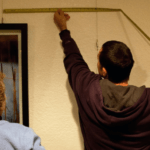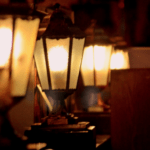Wood is one of the most versatile materials out there. You can cut it, carve it, shape it, and glue it. You can paint it, stain it, strip it, or finish it. You can put stuff on top of it or inlaid into it. The possibilities are endless!
You can make just about anything from wood. So, if you want to make a painted sign, a decorative box, or a craft for your home, you might be wondering what kind of paint to use on wood for your project.

Read on to discover more.
In this post:
- What kind of paint to use on wood crafts.
- Factors to consider when picking paints for wood crafts.
- Types of paints to use on woodcrafts.
- How to prepare wood crafts for painting.
What Kind of Paint to Use on Woodcrafts?
Acrylic paint, latex exterior house paint, or oil-based paint are the best paint for wood crafts. I have used all three, and they all work great.
The general rule is this; if the craft is going to stay inside, then use acrylic or latex. If you’ll place it outside, then use latex exterior house paint or oil-based.
Factors to Consider When Picking Paints for Wood Crafts
Are you thinking of starting a woodworking project?
Knowing what kind of paint to use on wood crafts can be overwhelming if you’re just getting started. There are so many different types of paint to choose from.
It’s best to ask yourself some questions before deciding what kind of paint will work best for your project.
- What do you want your final project to look like?
- Is this for indoor or outdoor use?
- What color do you want your finished product to be?
- How much time and effort are you willing to put into the project?
Lastly, personal taste and the results you want may influence the type of paint you choose.
Types of Paints to Use on Wood Crafts
Acrylic Paint
Acrylic paint is water-based paint that is essentially plastic, and it dries hard, so you can use on surfaces such as wood.
The main difference between acrylic paint and enamel paint is that it has oil, and acrylic paint does not, which means some of the chemicals are different.
The acrylic paints are available in two forms:
- Artist quality, and;
- Student quality.
The artist’s quality paints contain more pigment and binders, making them thicker and more vibrant. Student quality paints have less color and will not cover as well because of the thinner consistency.
Painting with acrylic
Using Acrylic paint on wood is a good idea becuase it dries fast, usually within 10 minutes. So you need to keep your brushes wet when using them by putting towels or paper around the brush handles. You can also use a spray bottle filled with water to mist your palette when working with the acrylics.
Use acrylic craft paint for:
- Most wood crafts.
- Large surfaces.
- Long-lasting projects.
Acrylic paints work well on large surface areas like bowls, plaques, and decorative boxes because they don’t drip or run easily. They also cover well with a few coats – two coats are typically enough if you’ve primed your surfaces beforehand.
Oil-Based Paint
Oil-based paint offers a smooth, long-lasting finish that is resistant to chipping and peeling. It’s perfect for furniture, trim work, and cabinetry because it doesn’t require primer or sanding between coats.
Oil-based paint is also easy to apply because it has a buttery consistency that glides on smoothly. However, oil-based paints have one drawback: strong fumes from the VOC (volatile organic compounds) that the color gives off while drying.
You’ll need to open windows and doors when using this type of paint, but if you’re painting indoors, there are water-based oil paints available that have less odor.
House paint
House paint is a great choice for larger projects, such as painting a decorative piece of furniture. When using house paint, you’ll need to apply primer before painting your piece. The primer will help cover any blemishes in the wood and give the paint a smooth surface to stick to.
You can also mix acrylic craft paint into your house paint to create any color you want. House paints that are labeled “low-VOC” or have a low amount of volatile organic compounds are better for the environment and safer for use.
Latex house paint is excellent for outdoor projects because it holds up well in bad weather conditions. You can buy latex house paint in any color, so if you can’t find the right shade of green at the craft store, head over to the hardware store!
How to Paint Wood Crafts
Surface Preparation
Before painting, you must prepare the wood surface. Follow these steps:
- Sand the wood surface with sandpapers of different grits to achieve a smooth surface.
- Wipe down the wood with a cloth dampened with mineral spirits. Let the wood dry completely before painting.
- Next, use a foam brush to apply a coat of primer to all sides of your piece. Let it dry overnight, and sand it smooth with fine-grit sandpaper.This will help the paint adhere better and make your piece extra durable.
Now you’re ready to use your preferred paint!
Painting Techniques
If your craft has intricate details, you can use a small paintbrush for more precise painting. However, if you are painting something larger, like a wooden box or sign, you may want to use a foam brush for better coverage.
Let each coat of paint dry completely before you add another layer of paint on top of it. Once you finish one coat, inspect the craft for areas that need more paint coverage and touch those up if necessary before moving onto the next coat of paint.
Keep adding layers until you achieve the desired level of opacity or shine.
Final Words
There is no one size fits all answer to what kind of paint you should use on wood crafts. Different paints are best for different projects. Be sure to find the best match for your project and the intended finish.
Join 25,000+ smart readers—don’t miss out!







